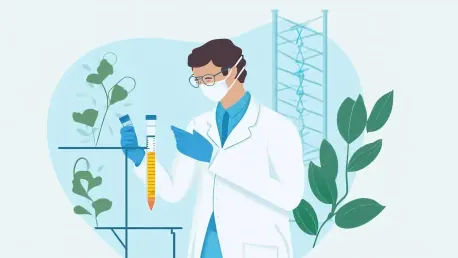The memorandum to President Trump suggests addressing the significant need for a cohesive strategy to manage biological risks through the establishment of a Unified National Biosafety and Biosecurity Agency. The driving factor behind this proposal is the potential for high-risk laboratory research and naturally occurring infectious diseases to cause pandemics, similar to or even more severe than COVID-19. The current fragmented system of biosafety and biosecurity oversight, distributed among multiple agencies such as the CDC, NIH, and USDA, has been critiqued for its inefficiency and potential vulnerabilities. This decentralization results in inconsistent regulations, unclear authority lines, and varied enforcement of compliance.
The Case for Centralized Oversight
Fragmentation and Inefficiencies in the Current System
The existing decentralized system of biosafety and biosecurity within the United States distributes responsibility across numerous agencies, leading to a lack of clarity, consistency, and overall inefficiency. The CDC, NIH, and USDA each have specific roles and regulations, but these can often overlap, creating redundancies and potential gaps in oversight. This fragmentation means that comprehensive coordination is lacking, and each agency operates within its own regulatory framework without a unified national standard, leading to varied enforcement of compliance. In an era where global connectivity heightens the risk of biological threats, this fragmented approach is inadequate for ensuring national biosafety effectively.
Furthermore, the multiplicity of agencies involved in biosafety creates confusion and hampers effective communication and coordination between stakeholders. Researchers, whether in government, academia, or the private sector, face a challenging landscape of differing regulations and standards that complicate the implementation of consistent biosafety practices. This not only slows down research processes but also increases the risk of non-compliance with critical safety measures. The absence of a centralized point of contact exacerbates these issues, underscoring the need for a unified system to streamline biosafety and biosecurity efforts across the nation.
Advantages of a Unified Agency
A unified national biosafety and biosecurity agency would address the critical gaps identified in the current system by centralizing oversight. This centralization would provide a consistent regulatory framework and eliminate redundancies, thereby streamlining processes and improving overall efficiency. The proposed agency would serve as a single point of contact for all stakeholders, including government, academia, and private sector researchers, simplifying the compliance landscape and fostering better communication. By establishing national standards for biosafety and biosecurity, the agency would ensure uniform enforcement of regulations, reducing the risk of non-compliance and enhancing the nation’s ability to respond to biological threats.
One of the significant benefits of a unified agency would be its role in conducting and sponsoring biosafety research. This centralized approach would allow for a comprehensive understanding of existing and emerging biological risks, facilitating the development of effective countermeasures. Additionally, the agency would be responsible for administering a comprehensive incident reporting system, ensuring timely and coordinated responses to any biosafety breaches. Furthermore, by providing education and workforce development, the agency would help build a skilled and knowledgeable biosafety workforce, further strengthening the nation’s biosecurity capabilities.
Enhancing Pandemic Preparedness and Bioeconomic Innovation
Financial and Strategic Benefits
The memo emphasizes that a consolidated approach to biosafety and biosecurity would not only improve government efficiency but also save taxpayer dollars by eliminating unnecessary overlap among existing agencies. By streamlining processes and centralizing oversight, a unified agency would reduce administrative costs and enhance the overall effectiveness of biosafety measures. This financial efficiency could then be redirected towards more critical aspects of managing biological risks, such as research and development, emergency preparedness, and response capabilities. Overall, this would create a more robust system capable of addressing the complexities of biological threats in a cost-effective manner.
Moreover, by positioning the United States as a global leader in managing high-risk biological research, the creation of a unified agency would bolster the country’s bioeconomic innovation. A centralized agency would facilitate collaborations between government, academia, and the private sector, driving forward advancements in biotechnology and life sciences. By fostering a synergistic environment that integrates biosafety considerations into research and development processes, the U.S. can enhance its bioeconomic competitiveness while maintaining high standards of safety and security. This dual focus on innovation and safety would ensure that the nation remains at the forefront of the global bioeconomy.
Addressing Current Deficiencies and Ensuring Future Readiness
The memorandum to President Trump recommends creating a Unified National Biosafety and Biosecurity Agency to address the critical need for a cohesive strategy to manage biological risks. The central concern driving this proposal is the danger posed by high-risk lab research and naturally occurring infectious diseases, which have the potential to spark pandemics as severe, if not worse, than COVID-19. Currently, biosafety and biosecurity oversight is fragmented across several agencies, including the CDC, NIH, and USDA. This dispersion has been criticized for its inefficacy and the vulnerabilities it creates. The decentralized structure leads to inconsistent regulations, unclear authority lines, and varied enforcement of compliance. By establishing a unified agency, the memorandum argues, the U.S. could ensure more consistent regulatory practices, clearer lines of accountability, and robust enforcement measures, ultimately enhancing the nation’s ability to prevent and respond to biological threats effectively.









